Wolfgang and Hans-Jürgen Büscher with the full electric plug-in R3e ZERO impact crusher.
The German company Büscher started in 1961 as a concrete plant and its business grew with, among others, a container service.
Today, so many years later, it is the first company in the world building a complete house out of 75 percent recycled construction and demolition waste. The load-bearing and non-load-bearing interior wall elements are made of 100 percent recycled aggregates.
They didn't just proved it is possible but also got approval of the Deutsches Institut für Bautechnik (DIBt). The German Federal Association for Building Materials gave its approval to use up to 100 percent of recycled aggregates, including crushed sand similar to type 3, to be used in their prefab load-bearing and non-load-bearing interior wall elements in exposure classes XC1 and X0 (dry).
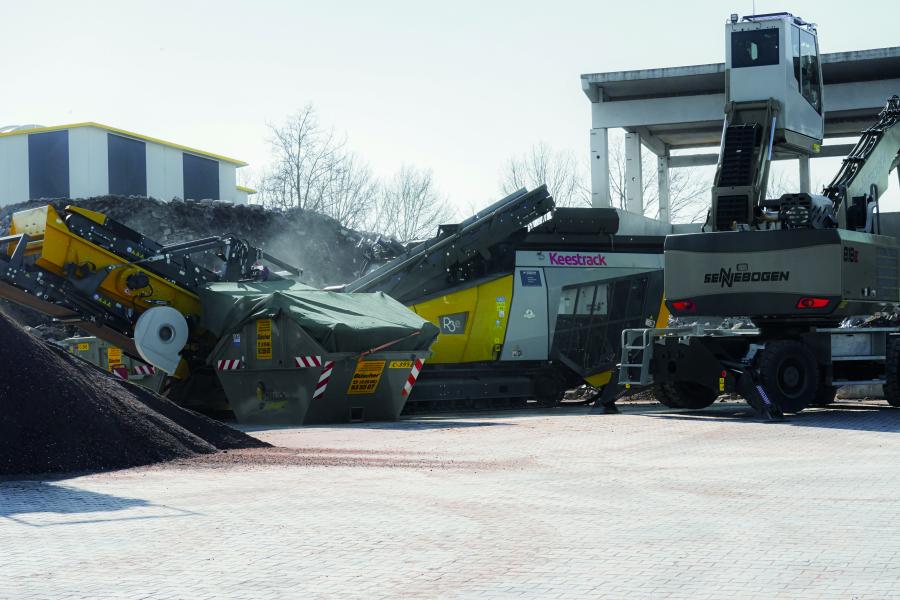
The R3e ZERO impact crusher with wind sifter crushes at zero CO2 emission.
Recipe for Concrete Has Changed
In 1961, Büscher made concrete like everybody else: from gravel, sand, cement and water. Today it has changed the recipe to 100 percent construction and demolition (C&D) waste to replace the sand and gravel completely and produce prefab load-bearing and non-load-bearing interior wall elements. The outside walls are not made out of recycled materials.
Due to its container service, the company Büscher received a lot of C&D waste which it normally recycled into aggregates for road construction. As this material was difficult to sell and available in high stock quantities, brothers Wolfgang & Hans-Jürgen Büscher started to look how this material could be re-used and came to the idea to use it as raw material for prefab concrete and concrete elements.
A beautiful sustainable idea but it was hard convincing specialists in the field and authorities this could be the future. Getting 100 percent prefab concrete certified was difficult, and took them 8 years of Research and Development to approval as most people didn't believe it was possible.

The K4e ZERO connected to the plug out functionality of the R3e ZERO. The complete production train is powered by sustainable solar energy.
"Concrete specialists, laboratories and certification specialists were very doubtful this could be done. They all said it is impossible and not legal," said Wolfgang Büscher.
Company Büscher asked researchers from laboratories and universities to scientifically prove what the material is capable of, and what it's not. They gave the parameters on what they wanted to achieve with the material and let them research if it stands the tests.
"By now all scientific research has been done and it shows exactly what is possible with the 100 percent recycled prefab concrete and concrete elements. The new material functions perfect and the recipe has changed at Büscher," said Hans-Jürgen Büscher.
Ing. Wolfgang Breit of the Technical University Kaiserslautern concluded: "the quality is good because the company Büscher took the right measures from the acceptance of the Construction and Demolition waste, the processing of the material and the use in the prefab concrete and concrete elements."
The main advantage of this certified production process is the efficiency in resources. They are using local highly available cheap C&D material and produce a sustainable, climate neutral product with less CO2 emission, saving as well on transport costs as the material at hand can be used.
"No costly raw materials are used so the price of the end products is also cheaper, a real win/win situation," said Thomas Overbeeke, operations manager of Büscher.
It took them 8 years of scientific proving you can sustainable build a house from fully recycled material, even at lower costs. But it took them only 4 months to build the complete three-family house, build with paint-ready prefab elements. Piping and electricity are all integrated in the prefab panels which have a smooth surface so you do not need any plaster. Now the first house is build out of 100 percent recycled natural mineral substitutes in the load-bearing and non-load-bearing interior wall elements. And when it is time to demolish it, it will be recycled into new concrete using the Büscher method. A true circular economy.
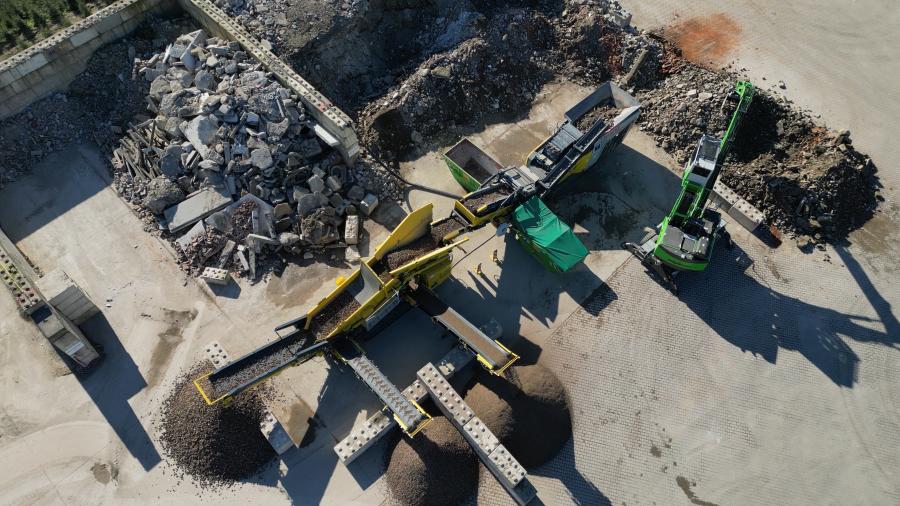
The Keestrack electric combination R3e and K4e ZERO seen from the air.
It is clear the company Büscher is minimizing the ecological footprint and is looking to close the material cycle for the circular economy. This is also the reason its factory and recycling site is powered by solar panels. The choice to use Keestrack crushing and screening equipment also is driven by this idea.
Oppermann & Fuss, Keestrack dealer in Germany have advised Büscher which ZERO equipment was the best fit for their applications and capacity. Also choosing the right options is essential in this specific application.
Zero Drive
Obviously a sustainable product should be produced with sustainable production equipment. As the Büscher site is equipped with solar panels delivering up to 323 kW/h of renewable electricity it is used to power the concrete factory but also to the Keestrack R3e ZERO impact crusher and the K4e ZERO screen. Both Keestrack machines are fully electric powered by renewable energy and do not have a combustion engine onboard.
As the electric motors drive most of the mobile crushing and screening equipment and power some necessary hydraulics systems both Keestrack machines run with ZERO CO2 emission.
Keestrack is known being an innovator and early adopter for electric e-driven equipment. The majority of the Keestrack product range is available in ZERO-drive.
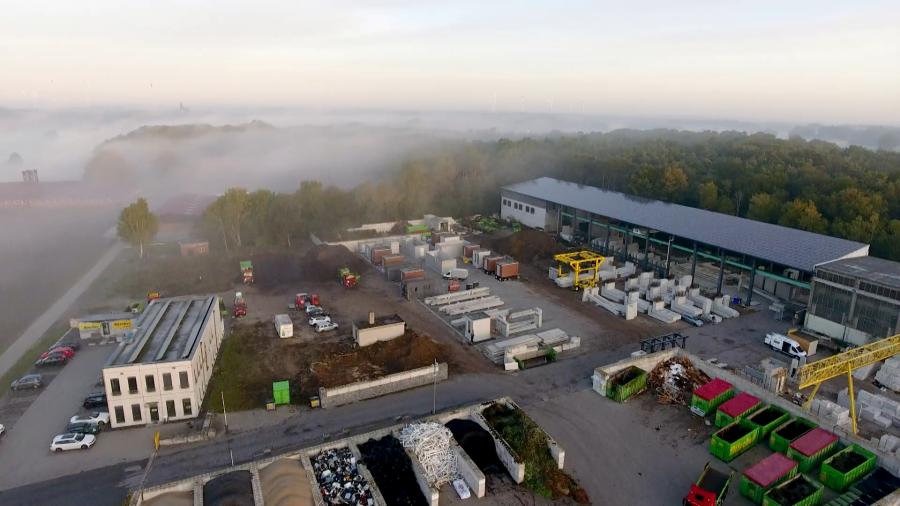
The job site of Büscher with its own solar power roof electrifying the Keestrack R3e and K4e ZERO.
When plugged in to the grid, like at the Büscher recycling site, where they use renewable energy using photovoltaic solar panels, the R3 and K4 are producing at zero carbon emission. The energy cost will be approximately 152kWh. Operational and maintenance cost will decrease drastically as there is no engine on board to maintain.
R3e ZERO Impact Crusher, K4e ZERO Screen
The innovative technology, its safety features and the design of the R3 impact crusher has won several European design prices, one of them being the Red Dot award. The very compact and easy to transport impact crusher available in; diesel/hydraulic drive , electric plug-in drive (with onboard backup diesel gen-set) and ZERO drive: full electric plug-in without gen-set backup, has a capacity up to 250t/h.
The Büscher company choose obviously the ZERO versions to minimize the environmental impact as it runs at zero carbon footprint, powered by its own solar energy.
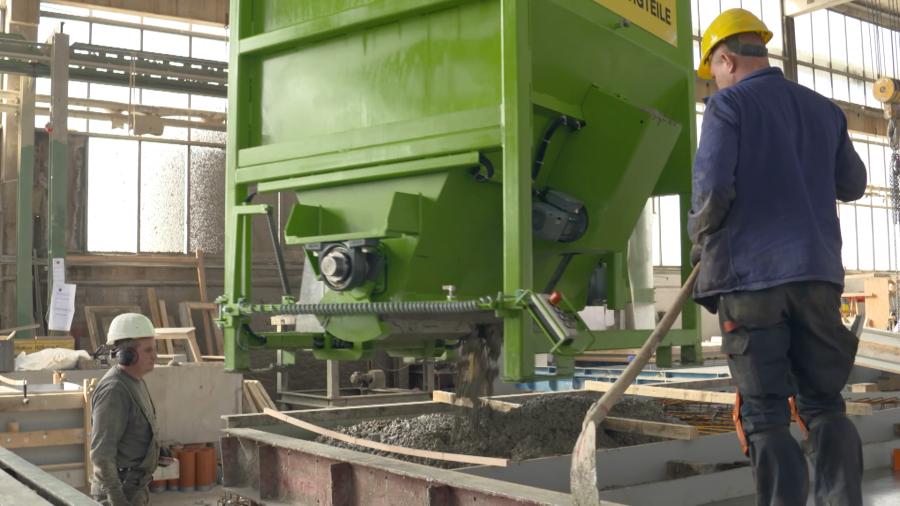
Pouring 100 percent recycled concrete into the casts.
The R3e ZERO is equipped with a vibrating feeder with a pre-screen of 1.200mm x 920mm to optimize crushing results and to minimize wear, an inlet opening of 770mm x 960mm (HxW) and a rotor diameter of 1.100mm and a rotor width of 920mm. The crusher equipped in closed circuit with recirculation conveyor and a precession screen of 3.100mm x 1.400mm produces a defined aggregate product size. The installed wind sifter eliminates contaminations of plastics, wood or paper and the overband magnet separates the metals. The R3e ZERO weighs 32t, and its plug-out of 125A, powers the connected K4e ZERO of 28t.
The K4e ZERO, has a high productivity with a capacity up to 350t/h. The double deck screen box of 4.200mm x 1.500mm, standard heavy duty plate apron feeder and hydraulic adjustable screen angle gives it very good screening capabilities. The numerous available options and screen decks make the K4 suitable for each job. At the recycling site of Büscher they choose to have the fine and middle fraction conveyor at the same side of the screen to improve the accessibility for the wheel loader.
Each Keestrack is designed to have good service access to minimize maintenance and repair times but at the Keestrack ZERO-range there are no engines on-board meaning maintenance is strongly reduced.
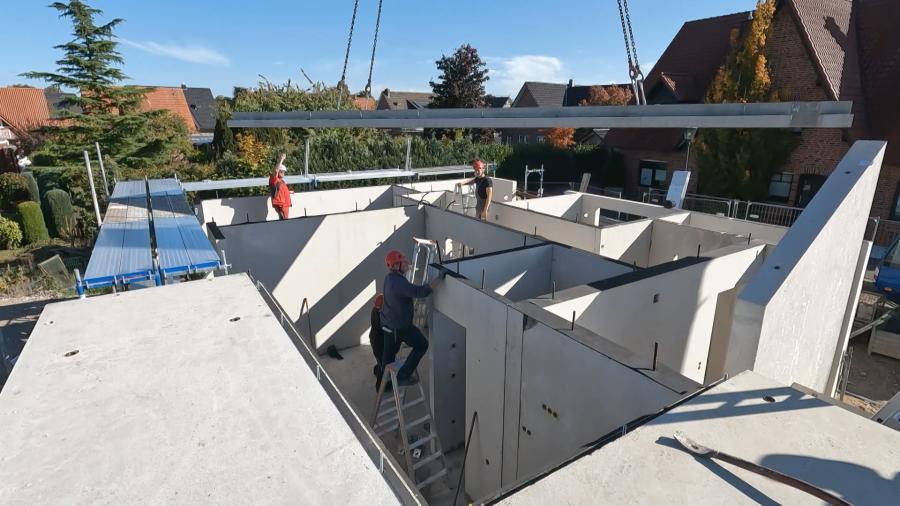
The wall panels and concrete elements used to build the complete "recycled" three-family house in just 4 months.
Both Keestrack machines at Büscher are equipped with remote controls to operate the crusher and screen from the excavator. They both have an integrated water spray system which can be used in case the production is too dusty. Also both are equipped with a Keestrack-er UMTS system. This telematics software system provides real-time data and analytics. The system enables you to check the location of the machines and if they are working correctly. All aspects of a machine can be checked and if necessary, remote updates to the software can be made.
It is possible to run diagnostic tests for all components including the feeder, screen, crusher and conveyors. The Keestrack-er also functions well for maintenance planning by Oppermann & Fuss, helping to keep machines in optimum shape.
For more information, visit www.keestrack.com.
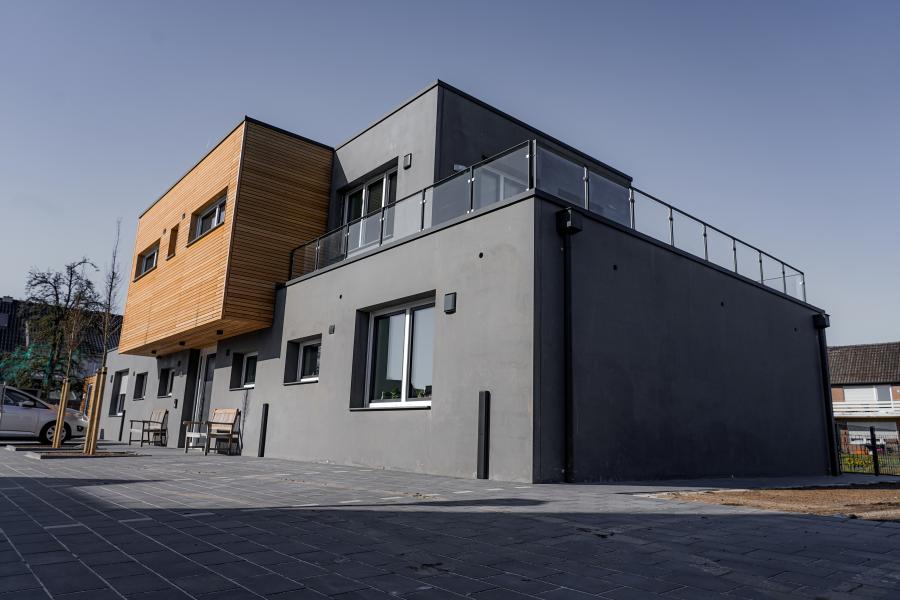
The three-family house build with prefab elements of 100 percent recycled natural mineral substitutes in use.
This story also appears on Aggregate Equipment Guide.
Today's top stories


























